Do you have a question about the Yamaha YZ450F 2010 and is the answer not in the manual?
Provides an overview of the Yamaha YZ series and the manual's purpose.
Outlines crucial safety guidelines, warnings for competition use, and protective apparel.
Lists minimum weight requirements for motocross machines according to F.I.M. regulations.
Explains how to navigate the manual using chapters and fore-edge symbols for efficient searching.
Describes the sequential, step-by-step format of procedures for clear disassembly and repair instructions.
Explains how to interpret exploded diagrams and procedure steps in the manual.
Explains the meaning of illustrated symbols used for specifications and lubrication points.
Identifies important labels specific to Canada, including fuel and safety warnings.
Identifies important labels for Europe, including CE marking and safety warnings.
Identifies important labels for Australia, New Zealand, and South Africa, including safety warnings.
Explains pictograms used for warnings and operational guidance, such as manual reading and tire pressure.
Lists and labels various parts of the vehicle in an exploded diagram for identification.
Explains the importance of serial numbers for parts ordering and theft identification.
Locates vehicle identification numbers and engine serial numbers on the frame and engine.
Identifies the location of the model label affixed under the rider's seat for spare parts.
Outlines the FI system and its main components, including sensors and the ECU.
Explains the operation of the fuel pump, injector, pressure regulator, and ECU in the FI system.
Lists and describes included accessories such as a detachable sidestand and tools.
Provides preparation advice for removal/disassembly, tool usage, and part handling.
Warns about static electricity and emphasizes careful handling of sensitive electronic components.
Details how to check electrical connections for stains, rust, and moisture to ensure proper function.
Lists special tools with part numbers and their uses for engine, chassis, and electrical maintenance.
Describes operation of engine stop switch, throttle, clutch, brakes, and starter.
Provides steps for starting the engine, break-in procedures, and fuel recommendations.
Lists critical points for torque checking after break-in or before each race for safety.
Provides instructions for machine cleaning and preventive measures for storage.
Lists general vehicle specifications including dimensions, weight, and engine type.
Lists maintenance specifications for engine components like cylinder head, cylinder, and camshafts.
Lists maintenance specifications for steering, suspension, and brakes.
Details maintenance specifications for electrical components like ignition and sensors.
Lists specific tightening torques for various engine components.
Lists specific tightening torques for chassis components like brackets and forks.
Specifies torque for standard fasteners and defines units of measurement.
Illustrates the lubrication system with numbered components for clarity.
Shows the routing of various cables and hoses on the motorcycle frame.
Provides a schedule for engine, chassis, and electrical maintenance based on usage.
Outlines essential pre-operation checks for coolant, fuel, engine oil, and brakes.
Explains coolant level checks, coolant changes, and radiator cap inspection.
Guides on adjusting clutch lever and cable free play for optimal engagement.
Details throttle cable adjustment, lubrication, and air filter cleaning.
Covers engine oil level checks, fuel line checks, and throttle body joint inspection.
Outlines engine oil change, oil pressure check, and idling speed adjustment.
Provides detailed steps for adjusting valve clearance when the engine is cool.
Explains brake system bleeding, front/rear brake adjustments, and pad replacement.
Details checking wheels, spokes, drive chain, and sprocket maintenance.
Guides on front fork removal, disassembly, checks, and damping adjustments.
Details inspection and removal/installation of steering stem, bearings, and ring nut.
Details swingarm removal, disassembly, and inspection of bearings and oil seals.
Provides handling notes, bearing removal, inspection, and installation for the rear shock absorber.
Details fuel tank removal, fuel extraction, pump service, and tank installation.
Covers throttle body removal, disassembly, checks, and replacement of components.
Lists electrical components with corresponding numbers for identification.
Displays the motorcycle's wiring diagram, showing connections between electrical components.
Outlines inspection steps for ignition system failures and spark plug checks.
Provides steps for troubleshooting the throttle position sensor and checking input voltage.
Provides instructions for connecting the FI diagnostic tool and checking fault codes.
Lists sensor operations and troubleshooting steps for various fault codes.
Provides steps for inspecting the fuel pump if it's not operating normally.
Discusses sprocket selection, tire pressure adjustment, and front fork setting factors.
Provides a table for diagnosing and adjusting front fork symptoms like stiffness or bottoming out.
Provides a table for diagnosing and adjusting rear shock absorber symptoms like stiffness or bottoming out.
Provides an overview of the Yamaha YZ series and the manual's purpose.
Outlines crucial safety guidelines, warnings for competition use, and protective apparel.
Lists minimum weight requirements for motocross machines according to F.I.M. regulations.
Explains how to navigate the manual using chapters and fore-edge symbols for efficient searching.
Describes the sequential, step-by-step format of procedures for clear disassembly and repair instructions.
Explains how to interpret exploded diagrams and procedure steps in the manual.
Explains the meaning of illustrated symbols used for specifications and lubrication points.
Identifies important labels specific to Canada, including fuel and safety warnings.
Identifies important labels for Europe, including CE marking and safety warnings.
Identifies important labels for Australia, New Zealand, and South Africa, including safety warnings.
Explains pictograms used for warnings and operational guidance, such as manual reading and tire pressure.
Lists and labels various parts of the vehicle in an exploded diagram for identification.
Explains the importance of serial numbers for parts ordering and theft identification.
Locates vehicle identification numbers and engine serial numbers on the frame and engine.
Identifies the location of the model label affixed under the rider's seat for spare parts.
Outlines the FI system and its main components, including sensors and the ECU.
Explains the operation of the fuel pump, injector, pressure regulator, and ECU in the FI system.
Lists and describes included accessories such as a detachable sidestand and tools.
Provides preparation advice for removal/disassembly, tool usage, and part handling.
Warns about static electricity and emphasizes careful handling of sensitive electronic components.
Details how to check electrical connections for stains, rust, and moisture to ensure proper function.
Lists special tools with part numbers and their uses for engine, chassis, and electrical maintenance.
Describes operation of engine stop switch, throttle, clutch, brakes, and starter.
Provides steps for starting the engine, break-in procedures, and fuel recommendations.
Lists critical points for torque checking after break-in or before each race for safety.
Provides instructions for machine cleaning and preventive measures for storage.
Lists general vehicle specifications including dimensions, weight, and engine type.
Lists maintenance specifications for engine components like cylinder head, cylinder, and camshafts.
Lists maintenance specifications for steering, suspension, and brakes.
Details maintenance specifications for electrical components like ignition and sensors.
Lists specific tightening torques for various engine components.
Lists specific tightening torques for chassis components like brackets and forks.
Specifies torque for standard fasteners and defines units of measurement.
Illustrates the lubrication system with numbered components for clarity.
Shows the routing of various cables and hoses on the motorcycle frame.
Provides a schedule for engine, chassis, and electrical maintenance based on usage.
Outlines essential pre-operation checks for coolant, fuel, engine oil, and brakes.
Explains coolant level checks, coolant changes, and radiator cap inspection.
Guides on adjusting clutch lever and cable free play for optimal engagement.
Details throttle cable adjustment, lubrication, and air filter cleaning.
Covers engine oil level checks, fuel line checks, and throttle body joint inspection.
Outlines engine oil change, oil pressure check, and idling speed adjustment.
Provides detailed steps for adjusting valve clearance when the engine is cool.
Explains brake system bleeding, front/rear brake adjustments, and pad replacement.
Details checking wheels, spokes, drive chain, and sprocket maintenance.
Guides on front fork removal, disassembly, checks, and damping adjustments.
Details inspection and removal/installation of steering stem, bearings, and ring nut.
Details swingarm removal, disassembly, and inspection of bearings and oil seals.
Provides handling notes, bearing removal, inspection, and installation for the rear shock absorber.
Details fuel tank removal, fuel extraction, pump service, and tank installation.
Covers throttle body removal, disassembly, checks, and replacement of components.
Lists electrical components with corresponding numbers for identification.
Displays the motorcycle's wiring diagram, showing connections between electrical components.
Outlines inspection steps for ignition system failures and spark plug checks.
Provides steps for troubleshooting the throttle position sensor and checking input voltage.
Provides instructions for connecting the FI diagnostic tool and checking fault codes.
Lists sensor operations and troubleshooting steps for various fault codes.
Provides steps for inspecting the fuel pump if it's not operating normally.
Discusses sprocket selection, tire pressure adjustment, and front fork setting factors.
Provides a table for diagnosing and adjusting front fork symptoms like stiffness or bottoming out.
Provides a table for diagnosing and adjusting rear shock absorber symptoms like stiffness or bottoming out.
| Engine Type | 449cc liquid-cooled DOHC 4-stroke; 4 titanium valves |
|---|---|
| Compression Ratio | 12.5:1 |
| Fuel Delivery | Fuel Injection |
| Transmission | 5-speed; multiplate wet clutch |
| Final Drive | Chain |
| Front Brake | Hydraulic single disc brake, 250mm |
| Rear Brake | Hydraulic single disc brake, 245mm |
| Front Tire | 80/100-21 |
| Rear Tire | 120/80-19 |
| Width | 32.5 in |
| Wheelbase | 58.5 in |
| Fuel Capacity | 1.6 gal |
| Wet Weight | 245 lb |
| Bore x Stroke | 97.0mm x 60.8mm |
| Front Suspension | 12.2-in travel |
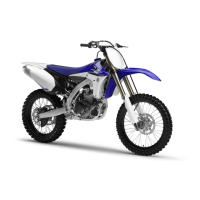
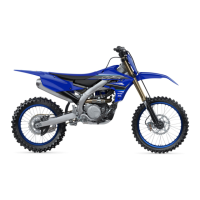
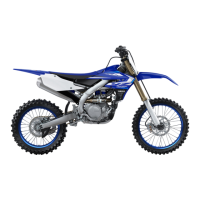



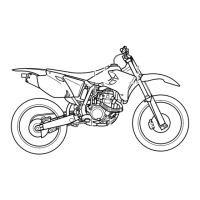




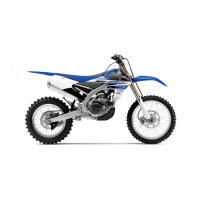
